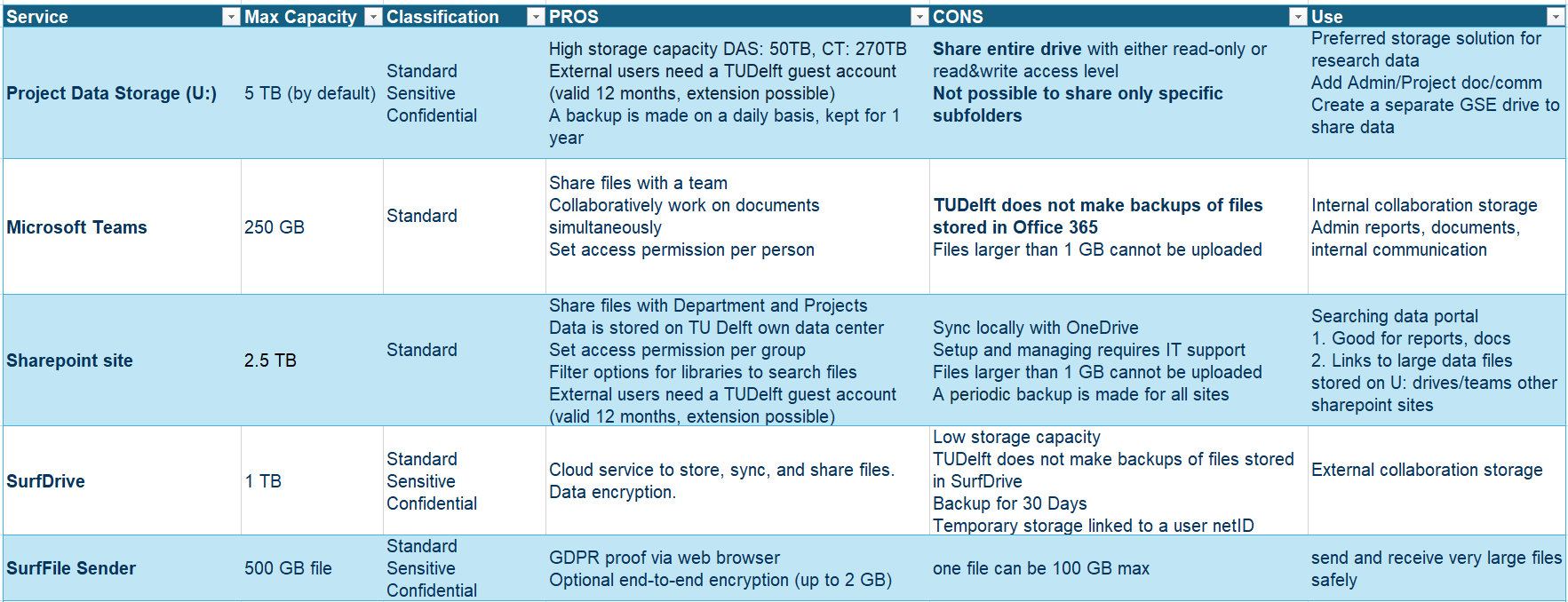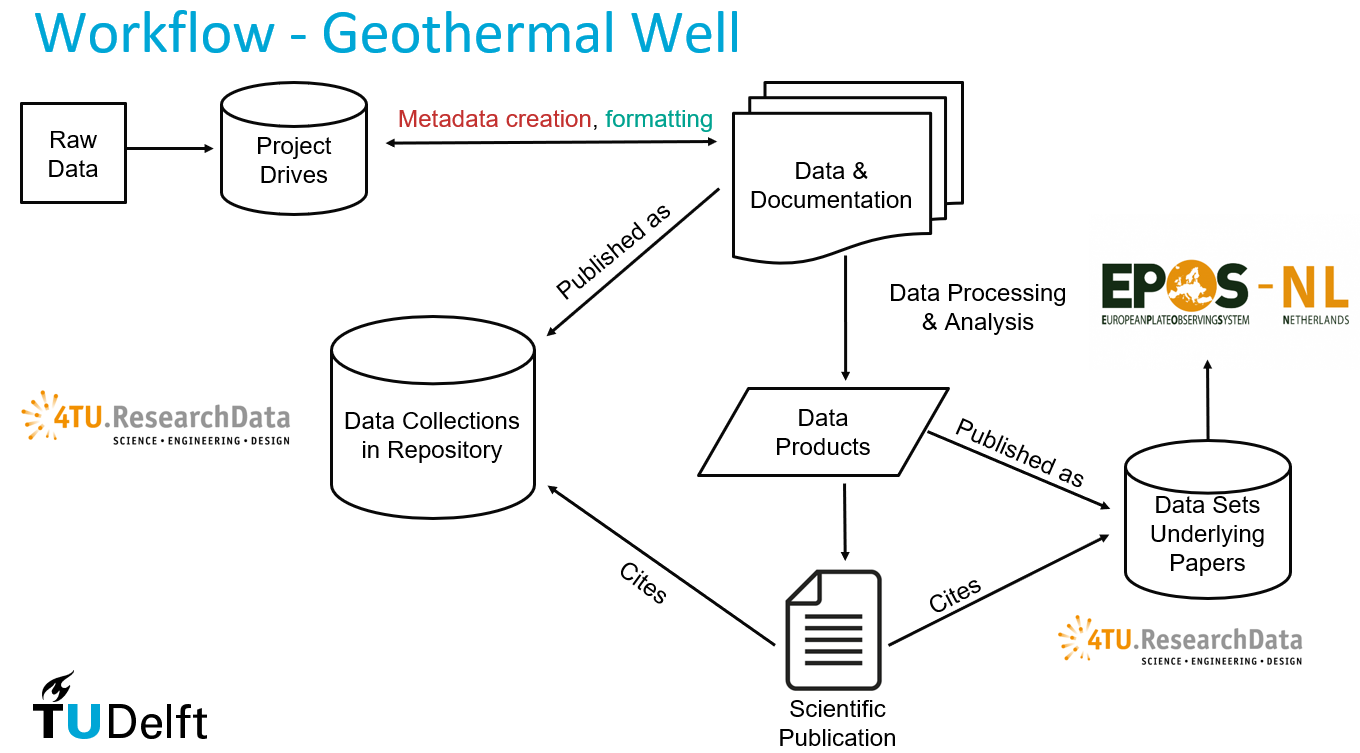Data Management and Storage#
ℹ Download images, presentations, files, and documents from DAPwellscienceteam/DataManagement/DataTypes&Storage.
To address potential challenges in collecting, storing, managing, and sharing data collected from the geotermal well, we have created a data management plan (DMP) which can be downloaded from DMPonline. This DMP will be updated as the project moves forward.
Data Storage#
Research data from the geothermal well and monitoring borehole are of high scientific value and must be securely stored and accessible to researchers. To address this in the DMP, we have used Storage Finder and concluded that the TUDelft Project Data Storage (U:) was the most reliable option.
⚠ However, Project Data Drive (U: Drive) lacks access controls needed for modern collaboration:
Members have access to the entire folder system,
Members have either READ-ONLY or READ-WRITE permission, and
Sharing data with external users is cumbersome and (most of the time) frustrating.

Below is a comparison of the data storage available with pros and cons to help researchers choose what is better for their type of data. Download this file from the DAPwell Team on TEAMS (only authorised members).

U:\DAPWELL_DATA Drive#
All research data produced by the geothermal well project are stored in the Project Storage Drive called U:\DAPWELL_DATA. This is the Master Copy where raw data and unchanged (static) data sets are stored. These data are shared with other researchers and may be input for other workflows.
Researchers have individual project drives to work on their data (dynamic) before depositing them in the U:\DAPWELL_DATA drive as listed below.
Data Stored |
Drive |
Admin |
|---|---|---|
Monitoring Station DAPGEO-02 |
|
Susanne Laumann & Phil Vardon |
Geothermal well DEL-GT-01 & DEL-GT-02 |
|
Susanne Laumann & Phil Vardon |
Geologic Model (Petrel) |
|
Hemmo Abels |
Geology & Petrophysics |
|
Hemmo Abels & Auke Barnhoorn |
Reservoir Simulation |
|
Denis Voskov & Alexandros Daniilidis |
Fibre Optics |
|
Guy Drijkoningen |
Data Management |
|
Susanne Laumann |
By default, all memebers of U:\DAPWELL_DATA have read-only access to prevent unintentional file modifications. Researchers who wish to store data files in this drive must request read-write access to the drive admin. Once the files have been deposited, access will be restored to read-only.
ℹ Administrators of Project Data Drives can give access by sending the netID of new members to the service desk or by using UMRA, which is already installed on TU Delft managed computers or it can be downloaded from the Software Centre otherwise.
CLICK here to know how add members to a Project Drive.
Open the UMRA application
Select Change Group Membership and click Next
Selec the Project Drive from the list and click Next
Select the group you wish to modify:
CONTRIBUTORS group has read and write permissions (files can be edited; no version control is available)
ADMINS group has read and write permissions and can add/remove users
READERS group has only read permissions (files can only be downloaded)
The ADMIN user can select the user from the list and click REMOVE
The ADMIN user can click ADD and type the name of the new user and click SEARCH. Then select the user netID from the list and click ADD
To change to the GROUPS list click back or finished
🗃️ Folder Structure#
We have consulted and implemented Best practices in the management of geothermal exploration data and organised data by research discipline. Other cathegories were added for easy access, such as sample databases and physical storage, photos, etc.:
Geologic data,
Borehole data,
Wireline logging,
Geophysical data,
Reservoir modelling,
Samples, etc.
CLICK here to expand U:\DAPWELL DATA folder structure.
U:\DAPWELL DATA
├───01_geologic_data
├───02_borehole_data
│ ├───drilling_reports
│ │ ├───Daily Look-Ahead Reports
│ │ │ ├───daily directional reports
│ │ │ ├───daily drilling mud reports
│ │ │ ├───daily drilling reports DDR
│ │ │ ├───daily geological reports
│ │ │ ├───daily lithostratigraphic column
│ │ │ └───daily mudlogging-lithologs
│ │ ├───PVA plots - directional plots
│ │ └───Weekly Reports
│ ├───end-of-well-report_EOWR
│ ├───final_aardyn_full_dataset
│ │ ├───Borehole_tracks
│ │ ├───Database
│ │ ├───GeoWellReport
│ │ └───Raw_Data
│ ├───final_report
│ └───well_design
│ ├───2021 design freeze
│ ├───2023 detailed well design
│ └───Drilling programme
├───03_core_data
│ ├───core_gamma_ray
│ ├───core_initial_description
│ ├───core_macro_ct_scans
│ │ ├───DAPWELL_TEST_20230330
│ │ ├───high-res-tiff
│ │ ├───low-res_jpg
│ │ └───raw-data
│ │ ├───extended-scale
│ │ └───normal-scale
│ ├───core_photos_drillsite
│ └───coring_reports
│ ├───final coring reports
│ └───individual core reports
├───04_sidewall_cores
│ ├───swc images
│ ├───swc initial description
│ └───swc photos
├───05_sample_databases
│ ├───core chips
│ ├───core_plugs
│ │ └───core plugs photos
│ ├───elabjournal
│ │ └───csv files from elabjournal
│ ├───old_drillsite sample registration sheets
│ ├───sample database
│ └───sample requests
│ └───Requests
├───06 core storage 00.31
├───07_well_logging
│ ├───interpreted data
│ │ └───Geomechanical study
│ ├───logging program
│ ├───processed data
│ ├───raw data
│ │ ├───BAKER HUGHES_WIRELINE_DELIVERABLES
│ │ │ ├───GT01_deliverables
│ │ │ │ ├───R1_BHP
│ │ │ │ ├───R1_CBL
│ │ │ │ ├───R1_SL
│ │ │ │ ├───R1_XMAC-HDIL
│ │ │ │ ├───R2_GXPL_UXPL
│ │ │ │ │ └───Run2-1_Processed_GXPL_UXPL
│ │ │ │ ├───R3_CN_ZDL
│ │ │ │ └───R3_MREX
│ │ │ ├───GT02_deliverables
│ │ │ │ ├───R1_FPI
│ │ │ │ ├───R2_DD
│ │ │ │ ├───R3_BHP
│ │ │ │ └───R3_DCST
│ │ │ ├───GT02_S1_deliverables
│ │ │ │ ├───R1_BHP
│ │ │ │ ├───R1_CBL
│ │ │ │ └───R1_XMAC_HDIL
│ │ │ └───GT02_S2_deliverables
│ │ │ ├───R1_BHP
│ │ │ ├───R1_CBL
│ │ │ ├───R1_XMAC_HDIL
│ │ │ ├───R2_GXPL_UXPL
│ │ │ ├───R3_CN_ZDL
│ │ │ ├───R3_MREX
│ │ │ ├───R3_SL
│ │ │ └───R4_R5_R6_CORING
│ │ └───deviation surveys
│ └───wellcad-files-figures
├───08_well_test
├───09_geophysical_data
│ ├───NAM_Monster_3D_R3481
│ └───TNO
├───11_reservoir_models
│ └───DAP model_v0 DARTS model
├───12_photos
│ ├───drilling site photos
│ └───drone videos
└───99_archive
Implementing a file naming convention was unsuccessful, particularly for data and reports delivered to us by other companies, as communication will always refer to original file names.
📝Metadata#
A description of the data is in readme.txt files, within most of the directories. It is essential to include information to let others understand the file contents, e.g., who and when was data collected, type of data, the level of processing, if any correction was applied, processing methods, parameter selection, software used for processing, etc.
A best practice is to add a readme file when storing data in this drive, to let other researchers make better use of the data. Metadata should be provided by the specialist or the data manager would create it based on the file content otherwise.
Data Access after Research#
Open access data services will be fully compatible and interoperable with the EPOS e-infrastructure. Data will be released publicly no later than at the time of publication of corresponding research papers.
However, data may be embargoed until the primary scientific publication describing the results is published. In some cases the raw data may be embargoed until all publications in the project have been published. Any embargo period will be consistent with the overall EPOS data policy, which is up to two years from the end of the data collection. During the embargo period, metadata will be made openly available. See for example DEL-GT-01 and DEL-GT-02 Wireline Logs.
TU Delft will have ownership of all scientific data collected in the geothermal well project, whereas the well operator will own any operational data collected. During the active phase of research, the geothermal well data manager in consultation with the scientific head and programme manager, will oversee the access to scientific data (and other outputs), as well as any requests for access from external parties. Related projects that require use of the scientific data, (e.g., EASYGO, WARMUP) will be given full access to the relevant data.
Data Licensing#
The geothermal well research data will be published via the institutional repository 4TU.ResearchData under the CC BY 4.0 license, unless other license is more suitable for the type of data. License CC BY 4.0 (Attribution 4.0 International) lets others distribute, remix, adapt, and build upon your work, even commercially, as long as they credit you for the original creation. This is the most accommodating of licenses, recommended by EPOS and NWO for maximum dissemination and use of licenced materials.
Data Publication Workflow#
When data is collected, the raw data will be stored in the designated storage, metadata will be created at the point of collection if data files do not contain acquisition information embedded. Digital files may be transformed to open file formats for wider dissemination (for example, from LAS to CSV). Raw data can be published at 4TU.ResearchData repository or being further processed and analysed. Documentation must be provided by the researcher in the form of a README file. Download this README.docx file and use it as template. Include as much information as possible to maximise result rerpoducibility and data reusability.
Follow the guidelines from 4TU.ResearchData repository to prepare a data set and publish it.
ℹ Don’t forget to use the geo-energy vocabulary and add them as keywords to enable EPOS MSL to discover the data set.

